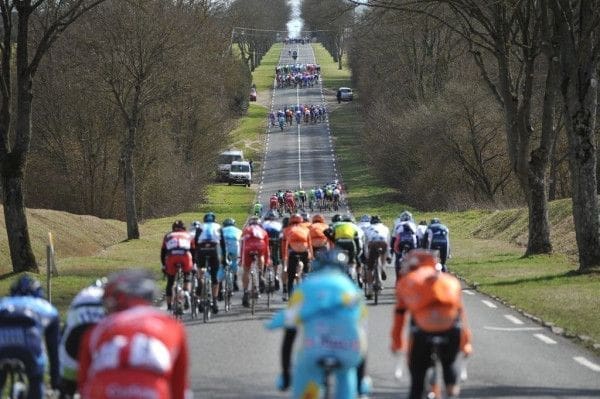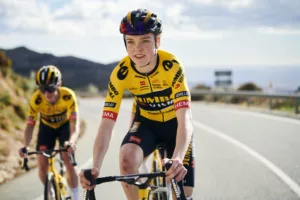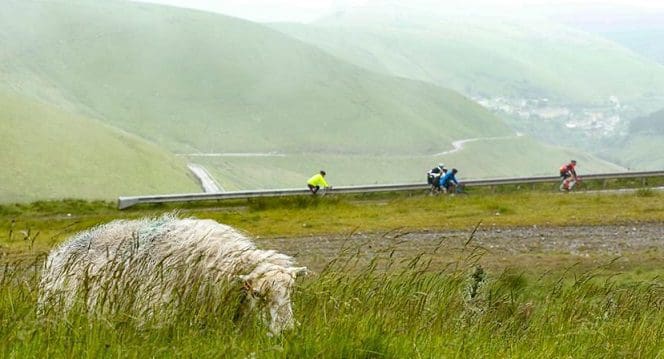Crosswinds are some of the worst conditions to ride in. Particularly when riding with deeper rims, each gap in a hedge or farm gate can see the whole bike move. This is especially scary when the front wheel moves in the wind. It’s this wheel unexpectedly snapping away that changes the direction you’re riding in. A deeper rear wheel is still affected but because it’s not in charge of steering, is more controllable. Unlike our Dutch counterparts who are used to riding in strong winds rolling in off the North Sea, us Brits seem to try our best to avoid riding in windy days.
Table of Contents
ToggleFamously, Geraint Thomas got blown off the road in the 2015 Gent Wevelgem race.

Cornering in Crosswinds
Leaning into a corner at speed in crosswinds can be an interesting experience. This is because you can experience some oversteer and understeer. The bike can oversteer when a wind from the right pushes you into a left-hand corner, suddenly you can find yourself aimed at the inside line of the grass verge. Conversely, with a wind from the left into a left-hand corner as you lean over to corner, you can find yourself pushed back upright a bit. Both types of corners are made more problematic by crosswinds.
Luckily there are a few tips to help you ride more safely in crosswinds and strong winds in general.
Tips for Riding in Crosswinds
Read the wind
Almost anything can help you work out the direction of the wind. From the more obvious like flags and weather vanes on your route to looking at trees and the grass. There’s always the old tried and testing licking of the finger for good measure too. A bit of pre-ride research helps wonders as well by checking the weather app on your phone. Sometimes conditions out on the differ slightly but it’s still useful information to have.
Knowing which way the wind is going at any point will give you a massive advantage over others who aren’t thinking about it. Whether that’s in races, sportives or just tanking round with your mates.
Position and protect yourself
Once you know which way the wind is blowing, it’s time to do something with that information! Every rider knows to ride behind a rider to get the effects of the draft. In crosswinds though, the sweet spot for drafting moves. If the wind is blowing from the left, then the best spot for drafting moves to the right of the rider in front. Naturally, when the wind blows from the right, this reverses. Riding close to the right of another rider is a potentially hazardous skill for new riders, particularly if the rider in front isn’t aware of your position. They can swerve to the right to avoid a pothole and take out an inattentive drafting rider.
This skill is best seen in pro races where echelons (the name for the formation of lots of riders riding offset to the side) can decide races. There’s a great Eurosport video below that explains in detail how and why echelons form, plus why they can be so decisive.

Prepare in advance
When you know which way the wind is coming from and if you know the route, then plan in advance. If you’re riding into a headwind and there’s a left hander corner approaching, then you know that the wind will turn into a crosswind. With that in mind, you should be able to move and get yourself in the best position for the change in riding conditions. Those who aren’t thinking ahead could find themselves stuck taking the wind and wasting energy.
On the bike
People generally ride on the hoods during every day rides. The hoods gives that reasonable balance between comfort and speed, whilst still being close to the shifters and brakes. To counteract some of the front wheel issues with crosswinds, some riders will try and get on the drops instead. Aside from having more responsive steering, this also shifts the rider’s bodyweight forward. This can increase stability on the bike. Alternatively some riders will stay on the hoods where they feel most comfortable but shift forward on their saddle a bit to achieve some of the same benefits.
Get in gear
I’m not sure the physiological, mechanical or technical reason for it but pushing a bigger gear helps when riding in tough winds. There’s a time to keep your cadence nice and high, spinning along. However the wind tends not to reward this pedalling style. Certainly larger riders who are able to put out more outright watts find the crosswinds and headwinds less tough compared to lighter riders. Just remember to ease back off whenever the wind turns and the magical tailwind appears!






